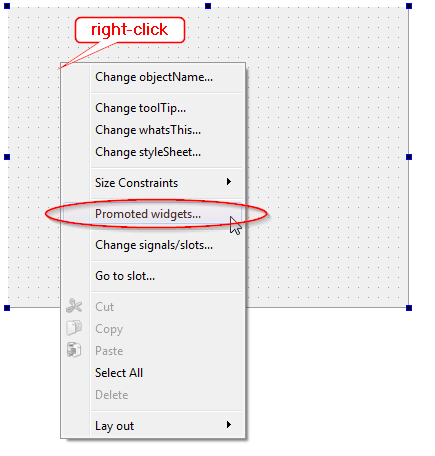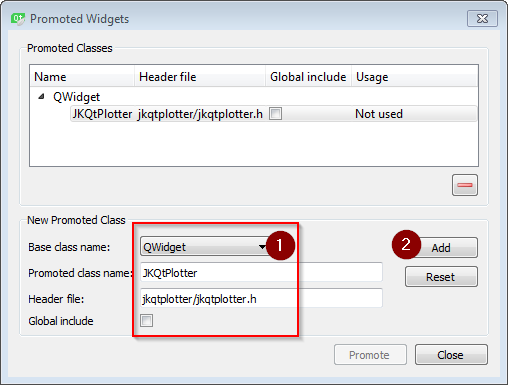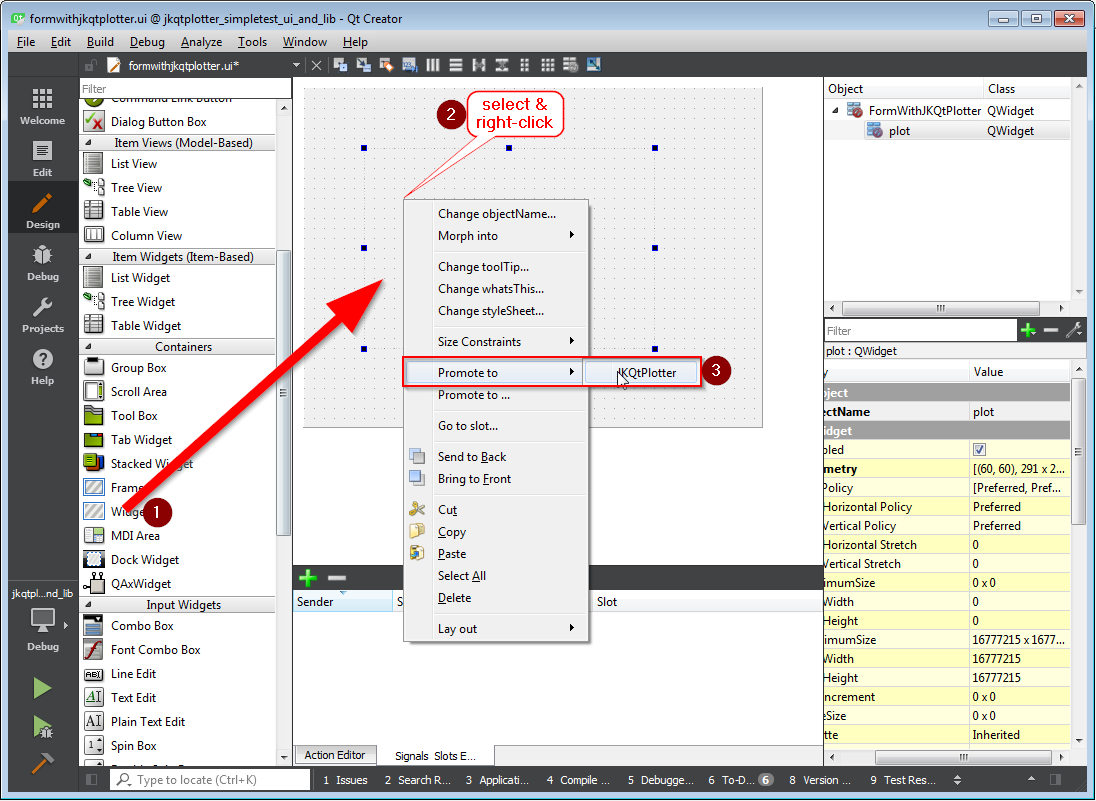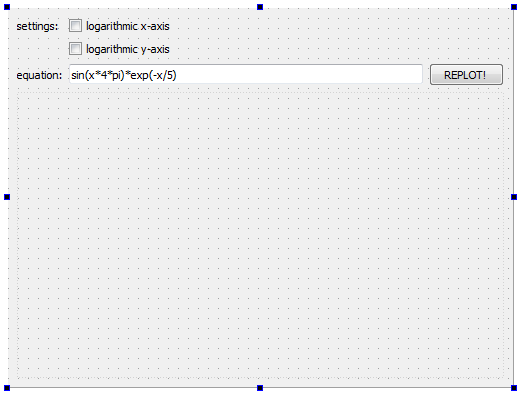mirror of
https://github.com/jkriege2/JKQtPlotter.git
synced 2024-11-15 18:15:52 +08:00
NEW/BREAKING: refactor CMake-Code, so static/dynamic switch is done via <code>BUILD_SHARED_LIBS</code>, which retires <code>JKQtPlotter_BUILD_STATIC_LIBS</code>, <code>JKQtPlotter_BUILD_SHARED_LIBS</code> and removes the capability to build static and shared libraries in one location (fixes issue #104) NEW: prepareed library for CMake's <a href="https://cmake.org/cmake/help/latest/module/FetchContent.html">FetchContent</a>-API NEW: the different sub-libraries JKQTPlotter, JKQTFastPlotter (DEPRECATED), JKQTMath, JKQTMathText can be activated/deactivated with CMake options JKQtPlotter_BUILD_LIB_JKQTPLOTTER, JKQtPlotter_BUILD_LIB_JKQTFASTPLOTTER, JKQtPlotter_BUILD_LIB_JKQTMATHTEXT, JKQtPlotter_BUILD_LIB_JKQTMATH
107 lines
4.0 KiB
Markdown
107 lines
4.0 KiB
Markdown
# Tutorial (JKQTPlotter): Using a JKQTPlotter inside a Qt User Interface Designer (UI) File {#JKQTPlotterQtCreator}
|
|
This project (see `./examples/ui/`) demonstrates how to create add a `JKQTPlotter` inside the Qt Form Editor (e.g. called from of Qt Creator) into a widget.
|
|
|
|
# Instructions on how to use JKQTPlotter in the Qt Form Designer
|
|
|
|
For this to work you have to follow the steps shown below:
|
|
|
|
1. add a new UI-file to your project and open it in the Form Editor. Then right-click the form and select `Promote Widgets ...`:<br>
|
|

|
|
|
|
2. In the dialog that opens, you have to define `JKQTPlotter` as a promotion to `QWidget` as shown below. Finally store the settings by clicking `Add` and closing the dialog with `Close`.<br>
|
|

|
|
|
|
3. Now you can add a `QWidget`from the side-bar to the form and then promote it to `JKQTPlotter`, by selecting and right-clicking the `QWidget` and then selecting `Promote To | JKQTPlotter`:<br>
|
|

|
|
|
|
|
|
|
|
In the example, there is a main CPP-file (shown below) and a `formwithjkqtplotter.ui`-file with the `formwithjkqtplotter.cpp/.h`-files that are used to implement the functionality behind the form (see next chapter).
|
|
|
|
The source code of the main application is simply instanciating the Form class `FormWithJKQTPlotter` from `formwithjkqtplotter.ui/.h/.cpp`:
|
|
```.cpp
|
|
#include <QApplication>
|
|
#include "formwithjkqtplotter.h"
|
|
|
|
|
|
int main(int argc, char* argv[])
|
|
{
|
|
QApplication app(argc, argv);
|
|
|
|
FormWithJKQTPlotter plot;
|
|
plot.show();
|
|
plot.resize(600,400);
|
|
|
|
return app.exec();
|
|
}
|
|
```
|
|
|
|
# Form Class `FormWithJKQTPlotter`
|
|
|
|
The Form was designed in the Qt Form Designer within Qt Creator, using the method described above (see `formwithjkqtplotter.ui`):
|
|
|
|

|
|
|
|
In addition the example implements some simple functionality in the `formwithjkqtplotter.cpp/.h`-files. A single graph, which parses and plots a function (from a `QLineEdit`) is added to the plot in the constructor:
|
|
```.cpp
|
|
#include "formwithjkqtplotter.h"
|
|
#include "ui_formwithjkqtplotter.h"
|
|
|
|
FormWithJKQTPlotter::FormWithJKQTPlotter(QWidget *parent) :
|
|
QWidget(parent),
|
|
ui(new Ui::FormWithJKQTPlotter)
|
|
{
|
|
ui->setupUi(this);
|
|
graph=new JKQTPXParsedFunctionLineGraph(ui->plot);
|
|
graph->setFunction(ui->edtEquation->text());
|
|
graph->setTitle(ui->edtEquation->text());
|
|
ui->plot->addGraph(graph);
|
|
ui->plot->setXY(-10,10,-10,10);
|
|
}
|
|
```
|
|
|
|
Then three slots react to user interactions. First two interactions set the x- or y-axis to linear or logarithmic, depending on the state of the two check-boxes. It also sets the scaling of the axes to meaningful default values:
|
|
```.cpp
|
|
void FormWithJKQTPlotter::on_chkLogX_toggled(bool checked)
|
|
{
|
|
ui->plot->getXAxis()->setLogAxis(checked);
|
|
if (checked) {
|
|
ui->plot->setX(1e-3,10);
|
|
} else {
|
|
ui->plot->setX(-10,10);
|
|
}
|
|
}
|
|
|
|
void FormWithJKQTPlotter::on_chkLogY_toggled(bool checked)
|
|
{
|
|
ui->plot->getYAxis()->setLogAxis(checked);
|
|
if (checked) {
|
|
ui->plot->setY(1e-3,10);
|
|
} else {
|
|
ui->plot->setY(-10,10);
|
|
}
|
|
}
|
|
```
|
|
|
|
A third slot is connected to the `clicked()`-event of the `QPushButton` labeled "REPLOT!". This slot reads the function from the `QLineEdit` and updates the plot with it:
|
|
```.cpp
|
|
void FormWithJKQTPlotter::on_btnReplot_clicked()
|
|
{
|
|
graph->setFunction(ui->edtEquation->text());
|
|
graph->setTitle(ui->edtEquation->text());
|
|
ui->plot->redrawPlot();
|
|
}
|
|
```
|
|
|
|
|
|
The result looks like this:
|
|
|
|

|
|
|
|
If you set both axes to logarithmic and modify the plotted function a bit, you get:
|
|
|
|

|
|
|
|
|
|
|